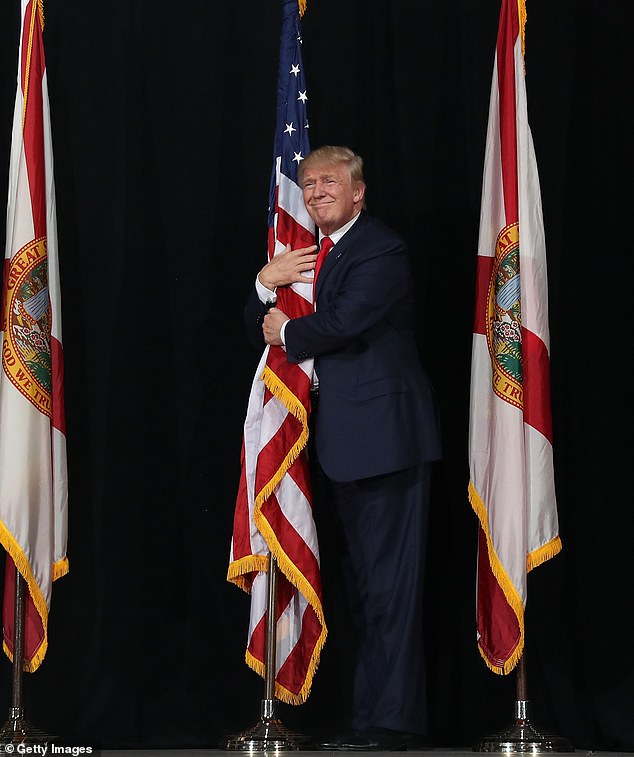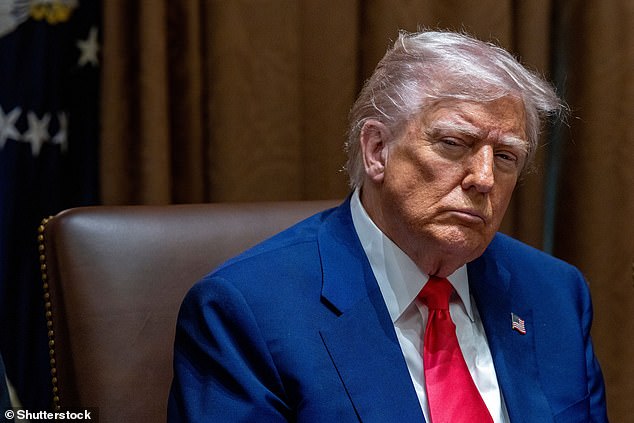So Donald Trump has a boss after all: the bond markets, where governments go to borrow and the careless to be taught a lesson.
Just as Liz ‘The Lettuce’ Truss, with her foolhardy attempt to borrow billions for tax cuts, found out the hard way that you can’t defy the bond markets, so self-styled Tariff Man has discovered you can’t upend the global trading system with a reckless return to protectionism without stirring the bond vigilantes into action.
They looked at how Trump’s cavalier imposition of tariffs on an unprecedented scale greatly increased the chances of a global recession, clocked that the Trump administration needed to refinance trillions of dollars of its existing debt in the months ahead while borrowing several trillion more in fresh debt – and promptly started dumping US government bonds (known as Treasuries).
The 10-year US Treasury, hitherto the reliable rock of international finance even in turbulent times, started to weaken precipitately, the cost of US borrowing began to rise, fast. The scary spectre of America being unable to borrow the trillions it needed – or being able to do so only at ruinous expense – suddenly became a possibility.
James Carville, former president Bill Clinton’s lead political strategist, was so in awe of their power he once said that, if he could be reincarnated, he’d like to come back as ‘the bond market’, adding: ‘You can intimidate everybody.’
Even Trump. The man who had airily dismissed the collapse of stock markets in reaction to his tariffs – even though he had until now always regarded the performance of US shares as the true metric for measuring his success – could not so easily dismiss the mighty bond markets. He blinked. Big time.
The so-called reciprocal tariffs he’d unveiled with such pride and panache in the
White House Rose Garden last week – and which had only been implemented a few hours before – were suddenly paused for 90 days (until July 8).

Donald Trump hugs the American flag during a campaign rally in Florida in 2016. The US President’s second term has got off to a tumultuous start as his tariff announcement sent financial shockwaves across the world
The universal 10 per cent tariff on every country (even ones populated only by penguins) would remain, as would the penal tariffs against China. For most countries it amounted to a welcome stay of execution.
White House insiders, who had insisted to all inquirers (including me) that a pause was not on the cards, were flabbergasted.
Trump and his clown chorus insisted this had been the plan all along: to scare the rest of the world into trade negotiations. Nobody believed this – not even those claiming it.
Trump’s top trade guru, Peter Navarro, dubbed a ‘moron’ and ‘dumber than a sack of bricks’ by Elon Musk (which probably qualifies Navarro for promotion in the Trump White House), had just written in the Financial Times that the Trump tariffs were ‘non-negotiable’.
But even Trump, who thinks he’s a ‘strongman’ cut from the same cloth as the dictators he so admires, had to retreat as turmoil in the debt markets beckoned, saying people were getting a bit ‘yippy’, which as explanations go was hardly elucidating — but clearly meant things weren’t going well.
For a brief period last week the markets rebounded strongly in the wake of the pause. There was talk of all the recent losses being recouped.
Trump even boasted of the tens of millions his colleagues had made from the recovery. But by Thursday morning it had dawned on the US stock markets that the pause was not all it was cracked up to be.
The markets resumed their decline. The dollar fell for the fifth consecutive day. Gold hit an all-time high. The Swiss franc, now regarded as a safer haven than 10-year US Treasury bonds, soared. US bond yields – the interest rates they command – remained elevated, signalling that the debt markets remained unconvinced Trump had turned over a new leaf.

Even Trump, who thinks he’s a ‘strongman’ cut from the same cloth as the dictators he so admires, had to retreat as turmoil in the debt markets beckoned,
He hasn’t. Even with the pause on reciprocal tariffs, the scale of the shock to world trade from those that remain is historic, with the average US tariff now around 25 per cent – greater than the infamous Smoot-Hawley tariffs (named after two US congressmen) which prolonged the Great Depression in the 1930s.
JP Morgan, a US mega-bank, thinks it’s ‘more likely than not’ that the US economy will start shrinking before 2025 is out, thanks to Trump’s tariffs and the huge uncertainty he’s created about the direction of American economic policy.
Team Trump boasts that 75 countries are now clamouring to do deals to avoid, or mitigate, the so-called reciprocal tariffs before the 90-day pause comes to an end.
No doubt some deals will be done. But there is not time (nor inclination in the White House) to do the comprehensive free trade deals of old. They will be partial and cobbled together in a hurry, leaving many tariffs and non-tariff trade barriers in place.
This will be bad for Britain. The Government thinks we’ve got off lightly amid the Trump tariff tsunami and reckons we’re at the head of the queue when it comes to new trade deals.
But, as I’ve said before on these pages, I see no sign Trump is prepared to negotiate away the 10 per cent minimum tariff which hits everybody – and our cars, other vehicles and steel face a 25 per cent tariff. Unless Keir Starmer can win marked improvements on both fronts it won’t be much of a trade deal.
In truth, the bigger danger to an open trading economy like Britain is not so much any specific tariffs Trump will continue to levy against us, but a global recession brought about by the chaos and confusion Trump is sowing.
Those who think that can now be avoided because Trump’s trade shenanigans have really come down to a slugfest between America and China have no idea how much damage a drawn-out trade battle between the world’s two economic superpowers will do to the rest of us – to say nothing of the risk of a trade war suddenly turning into a hot war.
It is tempting to think we’ve now reached the trade equivalent of George Foreman v Muhammad Ali, the famous 1974 Rumble In The Jungle which, against the odds, Ali won with a knockout blow in the eighth round. A contest in which the rest of us can watch from the comfort and safety of a ringside seat. Tempting. But wrong.
A trade war between China and America is already underway as both sides erect absurdly high tariff barriers against each other in tit-for-tat retaliation.
It is a classic illustration of the futility of protectionism on a grand scale. The two giants account for over one third of global GDP, one quarter of the world’s population and one fifth of global trade. Neither will emerge unscathed and between them they could easily tank the global economy.
Around $600 billion in goods is traded annually between the two countries. Much of that could now come to a grinding halt. Capital Economics, a consultancy, thinks half China’s exports to America could disappear. Societe General, a big French bank, is even gloomier: it fears Sino-US bilateral trade will be ‘largely wiped out’.
The US media is already reporting American factories cancelling Chinese orders because the tariffs will make their businesses uneconomic.
Chinese media says the country’s manufacturers are already laying off workers. Trans-Pacific container ship bookings are down a quarter since the end of March compared with the same period last year.
Our hearts may lift as early summer beckons but, for international trade, winter is coming.
For China, the risk is it will be shut out of its biggest export market at a time when its economy is already reeling from the bursting of several massive property bubbles and weak consumer spending. For America, where prices have already risen 24 per cent in the past five years, fewer cheap, high-quality Chinese products will mean another twist in the inflationary spiral.
Of course Trump could clinch a deal with President Xi to lower tariffs and establish fairer trade, as he could with those 75 countries supposedly camping out in the Oval Office anteroom. But that brings us to the conflict at the very heart of Trump’s push for tariffs.
On the one hand he says they will raise a ton of money and allow him to cut taxes. On the other he claims that US manufacturing will flourish in a new golden age behind high tariff walls. Well, dear reader, they cannot do both.
Either the tariffed goods continue to flow into America, albeit at a higher price, filling the Treasury coffers as they do so. Or new domestic production will replace imports, also at a higher price, in which case the revenues from tariffs will be sparse.
So what matters more to Trump? The re-industrialisation of America? Or a big new stream of revenue? I suspect he’ll have no choice but to plump for the money, which means new trade deals will not be as plentiful as many think.
The US is in a precarious fiscal position. Years of profligacy under Joe Biden and Donald Trump Mark I have seen America’s national debt balloon to a mind-bending $36 trillion — around 125 per cent of its massive GDP, the biggest in the world.
Around $9 trillion of that has to be refinanced, at higher interest rates, between now and the end of 2026. You will understand now why this was a foolish time for Trump to fall foul of the bond markets, whose traders set the level at which interest is charged.
But that’s far from the end of the borrowing story. Trump will run federal budget deficits of $2 trillion (over 6 per cent of GDP) this year and next, so that’s $4 trillion of new debt the US Treasury will have to issue on top of the $9 trillion of refinancing.
However even this massive borrowing binge does not take into account Trump’s desire to extend the tax cuts he introduced in 2017 and which come up for renewal this year. He doesn’t just want to roll them over, he wants to add to them by abolishing tax on tips, overtime pay and pensions.
Current official US budget projections, which are bad enough, take none of this into account. We could be looking at a US national debt that is over 130 per cent of GDP around the turn of the decade and annual budget deficits of 7 or 8 per cent of GDP for as far as the eye can see.
So you can understand why Trump wants – needs – billions from tariffs, especially now the bond markets are on to him.
Donald Trump rules by whim, guided by years of accumulated grievances, real and imagined. It is pointless trying to discern any coherent economic policy in them because it doesn’t exist. But the contradictions now swirling round the Trump White House threaten the global economy as much as they undermine the US economy.
It could all have been so different. Trump inherited a decent enough economy from Biden, the best in the G7 club of rich market economies: good growth, a strong jobs market, inflation coming under control.
If he had stuck to his more conventional economic agenda – widespread deregulation, moderate tax cuts, a ‘drill, baby, drill’ approach to fossil-fuel production – he could have presided over four years of rising prosperity.
But he wants to strut the world stage as a strongman, tariffs his weapon of choice. He was even prepared to rewrite history to justify their use, claiming the world trading system was rigged against America. It was all so much stuff and nonsense.
Despite the rise of China and other emerging economies, America has held on to a 25 per cent share of global GDP for decades while other Western economies, including the UK and EU, have seen precipitate declines. It is a remarkable achievement.
A half century ago real GDP per capita in America was under $28,000. Today it is $70,000. Another remarkable achievement.
So much for the rules being rigged against America. Why would they be? America wrote the rules.
None of this matters in Trump World, which exists in a parallel universe divorced from reality, where caprice and chaos rule. A wrecking ball has been deployed to destroy a system that produced the greatest rise in global prosperity in world history. We will all be the poorer for it.







